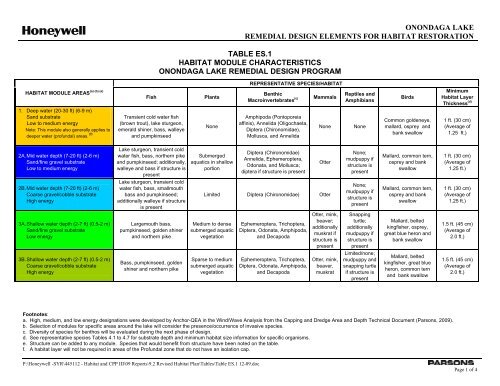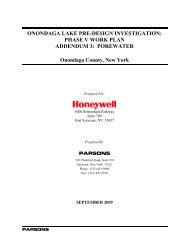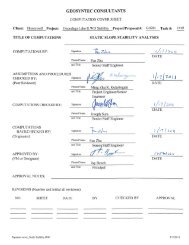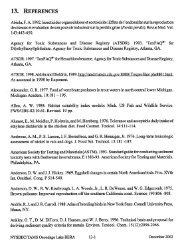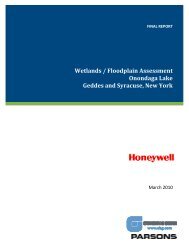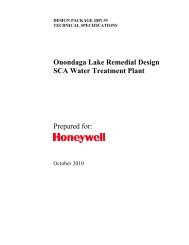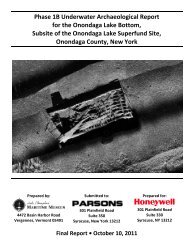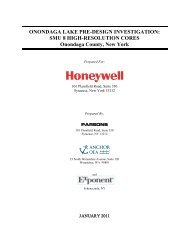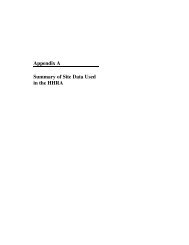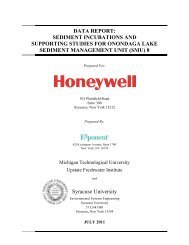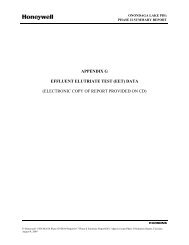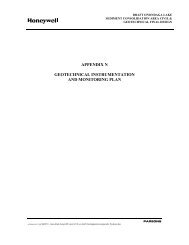Onondaga Lake Remedial Design Elements Remedial Design ...
Onondaga Lake Remedial Design Elements Remedial Design ...
Onondaga Lake Remedial Design Elements Remedial Design ...
- No tags were found...
Create successful ePaper yourself
Turn your PDF publications into a flip-book with our unique Google optimized e-Paper software.
ONONDAGA LAKEREMEDIAL DESIGN ELEMENTS FOR HABITAT RESTORATIONTABLE ES.1HABITAT MODULE CHARACTERISTICSONONDAGA LAKE REMEDIAL DESIGN PROGRAMREPRESENTATIVE SPECIES/HABITAT(a) (b) (e)HABITAT MODULE AREASFishPlantsBenthicMacroinvertebrates (c) Mammals Reptiles andAmphibiansBirdsMinimumHabitat LayerThickness (d)1. Deep water (20-30 ft) (6-9 m)Sand substrateLow to medium energyNote: This module also generally applies todeeper water (profundal) areas. (f)Transient cold water fish(brown trout), lake sturgeon,emerald shiner, bass, walleyeand pumpkinseedNoneAmphipoda (Pontoporeiaaffinis), Annelida (Oligochaeta,Diptera (Chironomidae),Mollusca, and AnnelidaNoneNoneCommon goldeneye,mallard, osprey andbank swallow1 ft. (30 cm)(Average of1.25 ft.)2A. Mid water depth (7-20 ft) (2-6 m)Sand/fine gravel substrateLow to medium energy<strong>Lake</strong> sturgeon, transient coldwater fish, bass, northern pikeand pumpkinseed; additionally,walleye and bass if structure ispresentSubmergedaquatics in shallowportionDiptera (Chironomidae)Annelida, Ephemeroptera,Odonata, and Mollusca;diptera if structure is presentOtterNone;mudpuppy ifstructure ispresentMallard, common tern,osprey and bankswallow1 ft. (30 cm)(Average of1.25 ft.)2B. Mid water depth (7-20 ft) (2-6 m)Coarse gravel/cobble substrateHigh energy<strong>Lake</strong> sturgeon, transient coldwater fish, bass, smallmouthbass and pumpkinseed;additionally walleye if structureis presentLimited Diptera (Chironomidae) OtterNone;mudpuppy ifstructure ispresentMallard, common tern,osprey and bankswallow1 ft. (30 cm)(Average of1.25 ft.)3A. Shallow water depth (2-7 ft) (0.5-2 m)Sand/fine gravel substrateLow energyLargemouth bass,pumpkinseed, golden shinerand northern pikeMedium to densesubmerged aquaticvegetationEphemeroptera, Trichoptera,Diptera, Odonata, Amphipoda,and DecapodaOtter, mink,beaver;additionallymuskrat ifstructure ispresentSnappingturtle;additionallymudpuppy ifstructure ispresentMallard, beltedkingfisher, osprey,great blue heron andbank swallow1.5 ft. (45 cm)(Average of2.0 ft.)3B. Shallow water depth (2-7 ft) (0.5-2 m)Coarse gravel/cobble substrateHigh energyBass, pumpkinseed, goldenshiner and northern pikeSparse to mediumsubmerged aquaticvegetationEphemeroptera, Trichoptera,Diptera, Odonata, Amphipoda,and DecapodaOtter, mink,beaver,muskratLimited/none;mudpuppy andsnapping turtleif structure ispresentMallard, beltedkingfisher, great blueheron, common ternand bank swallow1.5 ft. (45 cm)(Average of2.0 ft.)Footnotes:a. High, medium, and low energy designations were developed by Anchor-QEA in the Wind/Wave Analysis from the Capping and Dredge Area and Depth Technical Document (Parsons, 2009).b. Selection of modules for specific areas around the lake will consider the presence/occurrence of invasive species.c. Diversity of species for benthos will be evaluated during the next phase of design.d. See representative species Tables 4.1 to 4.7 for substrate depth and minimum habitat size information for specific organisms.e. Structure can be added to any module. Species that would benefit from structure have been noted on the table.f. A habitat layer will not be required in areas of the Profundal zone that do not have an isolation cap.P:\Honeywell -SYR\445112 - Habitat and CPP III\09 Reports\9.2 Revised Habitat Plan\Tables\Table ES.1 12-09.docPage 1 of 4


